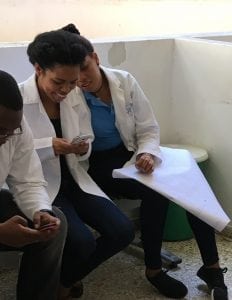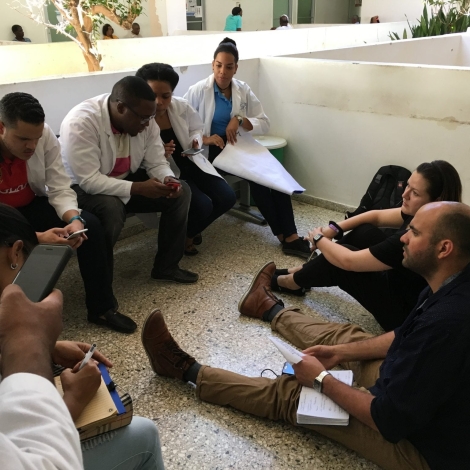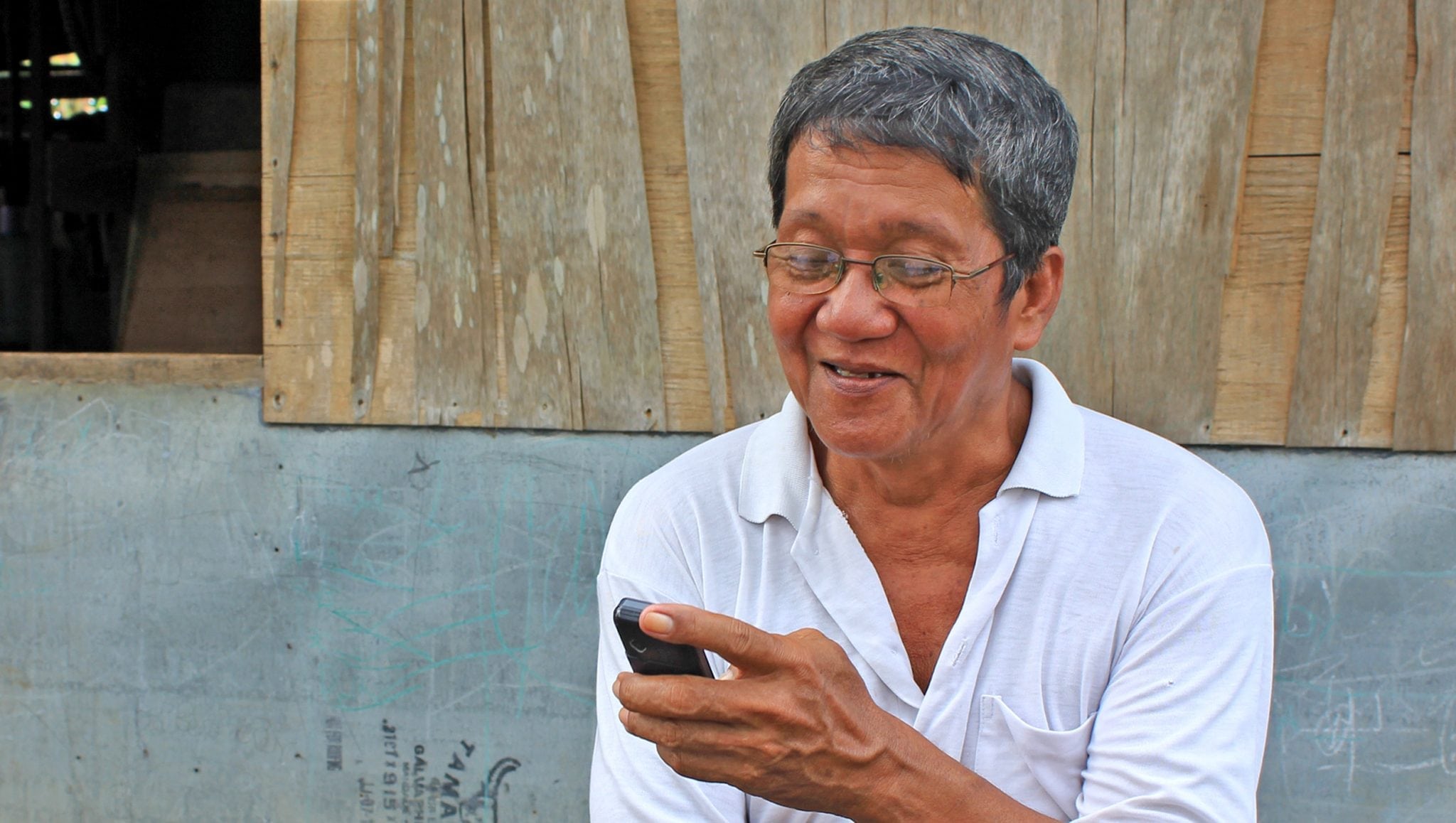
Dr. Ted Nelson, the author’s father, stands in a Nebraska wheat field. Dr. Nelson advocated for computer technology to farmers in the 1960s.
If there’s one thing I’ve learned about teaching ICT4D, it’s that every project needs to be a hybrid between technology and what I label “anthropology” – the assessment of the human factors of culture, behaviors, and most importantly, genuine need for tech solutions.
I grew up around computers, although my father’s 1960s machines were remote terminals connected to a university mainframe that filled a small room. He was something of a visionary, wrestling with the early buggy programs to prove to stubborn Nebraska farmers that these contraptions could help them with everything from taxes to optimum feed grain mix. I was the equally stubborn humanist, maintaining that the old ways were better – until I found myself as the executive director of a human rights organization. Suddenly I was an early adopter, introducing email and primitive social media to my own reluctant colleagues. I can see now that my father was pioneering incredibly useful tools to his rural clients, but finding the language to connect them was devilishly difficult.
“The findings were eye-opening…. A large percentage of the ideas were driven by technological innovation for its own sake.”
When I started teaching at Columbia in 1995, there was still a sharp divide between the technologists and the humanists, who were reluctantly coming around to word processing. But in 2007, push came to shove. My media and communications program at the School of International and Public Affairs needed a course that addressed digital innovations. There was no one else to teach it, so I raised my hand.

The author’s students worked with healthcare professionals in the Dominican Republic to research ICT4D to assist their work.
The school specializes in solutions-oriented policies for the developing world, and I figured that the first task at hand was to separate the useful innovations from the hype. For five years I sent my 25 international students on a scavenger hunt to track down applications of digital media in a development context, subject them to rigorous scrutiny, and publish the results on a Columbia-hosted Wiki. At the same time, I was tapped as a consultant by organizations ranging from the Gates Foundation to the US State Department to evaluate proposals and projects in the realm of ICT4D.
The findings – from both the research seminars and the consulting – were eye-opening. Donors of every description were eager to jump on the digital bandwagon. But a large percentage of the ideas were driven by technological innovation for its own sake, rather than the needs of the purported beneficiaries. Indeed, a great deal of research went into the tech side, and very little into the problems and practices of the recipients. Proposals were often based on the staggeringly wrong assumption that everyone in the world was connecting at the same speed as the proposers, or had the same desires and needs for information.
“Proposals were often based on the staggeringly wrong assumption that everyone in the world was connecting at the same speed, or had the same needs for information.”
We heard accounts of projects’ social impact. Some were negative – such as my Ethiopian student’s report that a One Laptop Per Child program disrupted an entire year of fourth-grade education in her country. Thousands of dollars of technology was placed in classrooms without training the teachers in its use, at a time when they had gone unpaid for months. Others were success stories, such as the well planned and executed OLPC project in Uruguay that optimized its educational benefits. We recorded costly, grandiose projects that mainly benefited their US instigators, and small, modest projects that took root and blossomed, like Africa’s digital currency mPesa.
After a few years, I felt we had learned some first ICT4D principles.
- Do a careful landscape analysis of pre-existing conditions and needs before you start.
- It’s imperative that this includes an assessment of existing communications infrastructure and cost structure for the entire population – rich and poor, urban and rural (unless you’re just looking to develop a market among the economic elite). This should include a careful evaluation of the electrical grid. Don’t assume everyone has access to an electrical supply, and don’t expect every supply to be reliable.
- Research user behavior, and beware projects that expect a rapid adoption of unfamiliar practices (unless you’re concentrating on a youthful demographic, in which case you might have a chance).
- Study cultural patterns. In many African villages, for example, husbands take charge of devices in the family. Offering a cell phone to a women’s association, as opposed to an individual, may be the only way to serve the female population.
- Learn from best practices. BBC Media Action is a leading organization in the field of ICT4D that has an unusually robust research program with extensive online publications.
- Adapt the technology to your findings if you want short- to medium-term results. If you’re working on maternal-infant health, you’re working within a very brief window of time to affect many lives. Maybe their region will have broadband and 4G networks in the future, but in this case, the future is now.
- Evaluate your results, and conduct follow-up evaluations where possible. Assiduously record your mistakes and false steps, because there will be many if you’re being truly innovative. Learn from them, analyze them, share them. Not every approach will yield good results, especially the first time out, but it’s critical to understand why it didn’t work. (It’s also important to understand the “why” of successful efforts.)
- Take advantage of local and volunteer initiatives. If someone has already identified a need, you may get more traction helping them to identify and refine technology that can leverage their efforts than starting from scratch.
- In your team efforts, combine the “engineers” and the “anthropologists.” The technologists’ role is obvious. The “anthropologists” will bring an array of skills to evaluate the “human factor,” as well as the underlying institutional framework, whether government, private sector, or cultural.
- Engage local partners from the beginning, with the goal of technology transfer and making yourself obsolete. Achieving local ownership is the gold standard of ICT4D success, especially if it can be self-supporting and scalable.
After seven years of conducting the research seminar, I was eager to test these principals in the field. Teaching ICT4D in the classroom was humbling, because my classes always had graduate students who knew more about their specialized fields than I did. I learned how to relax and learn along with them, posing the questions and seeking solutions in a collaborative fashion – a far cry from the “top-down” didactic style of my own education.
“I learned how to relax and learn along with them, posing the questions and seeking solutions in a collaborative fashion.”
I now work with the Masters of Public Administration in Development Practice program (MPA-DP) at Columbia’s School of International and Public Affairs. There I’ve overseen a series of capstone projects in which my student teams have developed ICT4D ideas to address problems in the developing world. The most advanced of these to date is the spring 2017 Project in Offline Education in Medicine (POEM) in the Dominican Republic, carried out in partnership with the Mount Sinai Global Health Program and the Wikimedia Foundation, with Adam Holt of Internet-in-a-Box. Working with Mariela Machado, a 2016 SIPA graduate and now Program Manager at Engineering for Change, we researched the informational needs of rural clinics in the Dominican Republic and the potential of offline digital computing to address them. The student team conducted the assessments listed above, and came up with an approach that has undergone field trials over the summer.
The benefits are obvious to every doctor who has practiced in disadvantaged rural areas of Latin America. If the institutions that support ICT4D initiatives are open to the principles outlined above, the project and its offshoots can share those benefits with the wider world.
Ms. Nelson’s students published an account of their work in the Dominican Republic in June in Foreign Affairs.
Anne Nelson has taught at Columbia University since 1995. She specializes in international media development, and was formerly the director of the International Program at the Columbia School of Journalism and executive director of the Committee to Protect Journalists. She was a war correspondent in Latin America, and reported from Eastern Europe and Asia, with work appearing in the New York Times, the Los Angeles Times, Harper’s, BBC, CBC, NPR and PBS. Her writing has won six awards, including the Livingston Award for international reporting.

